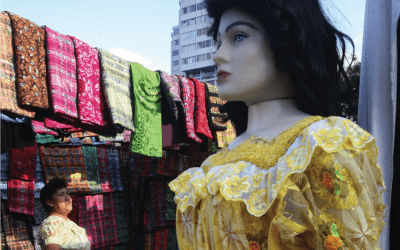Sensual Not Beautiful
The Mulata as Erotic Spectacle
While white actresses and models still dominate beauty and fashion magazines in Brazil, on my last few visits to Brazil, I’ve noticed that actresses of African descent such as Camila Pitanga and Taís Araújo have also graced the covers. Since 2009, both actresses have also starred in telenovelas. Miss Brazil 2016 is the first black winner since Deise Nunes’s crowning in 1986. The 2016 competition had the largest number of black candidates in its history. The dominant conceptualizations of beauty in Brazil are shifting. Erika Moura, the Mulata Globeleza of 2017, did not appear as a bodypainted nude Rio de Janeiro samba dancer, but instead performed in various costumes and dance styles representing a breadth of Brazilian regional cultures.
It’s certainly not been this way for very long. In 2001, on my first trip to Brazil, I yearned to find a refuge, a place where my background as a mixed-race black woman from the United States was neither exotic nor fetishized. Relying on Brazil’s reputed celebration of racial mixing, I believed that it would become my racial paradise in which brown was beautiful and I would find a resistance to the exclusivity of white U.S. beauty norms.
Instead, I became familiar with a Brazilian saying, “Branca para casar, mulata para fornicar, negra para trabalhar (white women for marriage, mulata women for sex, black women for work).”
The elegant beach neighborhood of Copacabana displayed advertisements of “authentic” Brazilian mulatas (a woman of mixed African and European descent) featured in a samba show, hinting at brown mulata carnality to sex tourists. The newspaper stands, like their U.S. counterparts, were full of magazines with “beautiful” white women on the cover. Likewise, the dominant Brazilian culture and media emphasized white feminine beauty versus sensuality derived from African origins.
Beauty is not only a matter of visual aesthetics, but intimately tied to notions of race, sexuality, gender and class. The legacies of African slavery and European colonization that prescribed these norms are still evident as white women represent ideals of beauty and chastity, the mulata woman represents sensuality and sexual desire, and black women represent manual labor.
THE “MIXED” HISTORY OF THE MULATA AND COLONIAL MYTHMAKING
Thus, the mulata is often thought of as an embodiment of the eroticism of black and white mixing. Laura Moutinho notes in Razão, Cor e Desejo that female slaves were imagined as seductresses who initiated sex with white men, rather than their victims (2004). As Donna Goldstein argues in Laughter Out of Place, the historical mythmaking of the Brazilian colonial project has interpreted miscegenation through cordiality rather than coercion (2013). This vision of interracial sex during slavery and the fantasy of master-slave relations romanticizes sexual violence and exploitation of women and informs contemporary commodification of mulata sexuality.
After the abolition of slavery in 1888, the majority of the population was of African descent. The Brazilian white elite struggled to reconcile the desire for white modernity with its newly emancipated black and mixed-race population that haunted the national racial future and threatened the preservation of racial hierarchies. Brazilian elite and intellectuals yearned to appear on par with Europe and strove to modernize and whiten the population through European immigration and the eventual elimination of nonwhite bodies. The exclusive valuing of white bodies as beautiful—and hence civilized and superior—reflects a history based on the enslavement of people of African descent and the confiscation of land from indigenous groups.
Nevertheless, a transition was taking place. By the 1930s, the Brazilian state, along with many intellectuals, began to present racial diversity and mixing as a positive characteristic of the Brazilian nation, though still from a dominant white viewpoint. The Brazilian mulata became a key symbol of the national identity grounded in mestiçagem (racial mixing). Brazilian sociologist Gilberto Freyre’s influential work Casa grande e senzala (1933) suggested that slavery brought different races together in harmony. For Freyre, the object of the mulata’s seduction is the innocent and inexperienced white male. Through her he gains the corporal knowledge of brasilidade (Brazilianness). As Sonia Maria Giacomoni argues in Mulher e escrava, this framework functions in part because Freyre constructs inter-racial sexual relations as a love allegory, ignoring colonial and sexual violence (1988). His vision of a racially harmonious Brazil and the mulata as evidence of that history anchored the dominant ideology concerning race, gender, sexuality and national identity. His erotic narrative celebrates the mulata as a unifying symbol of brasilidade.
Following this logic, Getúlio Vargas’s authoritarian regime (1930–1945 and 1950–1954) began to celebrate elements of Afro-Brazilian culture such as samba and carnaval as national culture starting in the 1930s, and the tradition continues today. Together the mulata, samba, and carnaval samba became intertwined as symbols of national unity and racial democracy. The carnaval Samba Queen became a symbol: a dancing mulata, wearing high heels and a giant feathered head-dress and little else, personified this notion. For both domestic and foreign consumption, the sexualized samba-dancing mulata body became proof of racial harmony.
As a key figure of national and transnational desire, the mulata was famed for her corporal functions—sex and dance. Beginning in the 1970s, Brazilian governmental tourism agencies utilized the image of the sexually available mulata for the promotion of Brazil as a tourist destination. From the 1970s to the 1990s, white Rio de Janeiro businessman Oswaldo Sargentelli, a self-described mulatólogo (mulata expert), presented samba spectacles of scantily clad dancing women to the Brazilian elite and tourists alike. With the branding of brasilidade as a sexual paradise of mulatas, the archetype of the sensual sexually available mulata who dances with abandon became a thematic fixture memorialized in popular Brazilian cultural politics and in the international imagination.
MULATA GLOBELEZA AND CARNAVAL: CRYSTALYZING THE MULATA ICON
Televisual and performance spectacles show the iconic mulata female body in Brazil as glistening, brown, sensuality in the flesh. In 1992, Globo TV’s (Brazil’s dominant television network) carnaval-related programming featured the “Mulata Globeleza,” a body-painted nude dancing muse of carnaval. The Mulata Globeleza plays on the words Globo (the network station) and beleza (beauty). Bringing audiences across Brazil into carnaval, the Mulata Globeleza appears dancing in a continuous array of vignettes. Created by Austrian visual designer Austrian Hans Donner, the Mulata Globeleza dances against a blank screen while swirls of glittery paint cover her vaginal area and colorfully adorn her moving frame. With exclusive transmission coverage of carnaval programming and Rio de Janeiro’s samba school parades, the mulata body functions as Globo’s commodified network carnaval symbol.
Transmitting mulata sensuality and fantasy on screen, the Mulata Globeleza also contains colonial memories, the contradictions between an espoused racial democracy and the realities of racial disparities, and the construction of a Brazilian national identity based on the romanticized erotics of racial mixing. Valeria Valenssa, Donner’s wife, appeared as the Mulata Globeleza from 1993 to 2005. Lauding the mulata as the muse of carnaval, Donner says, “a cor do Brasil, que para mim é a mistura das raças, o design perfeito. A mulata é um design de Deus e, por incrível que pareça, não se encontra em lugar algum do mundo” (the color of Brazil, which for me is a racial mixture, the perfect design. The mulata is the design of God, and as incredible as it seems, is found nowhere else in the world). Through the metaphors of eugenic design and unique brasilidade, Donner’s mulata muse invokes Brazilian racial mixing, yet she remains onscreen as a flat silent symbol. Her objectification and design remain under the authority of a patriarchal order. Furthermore, the celebration is only temporally and spatially constrained as she is validated as a model only during carnaval and on the samba stage. After Valenssa’s body changed because of her pregnancy, Globo abruptly dismissed her. In dismissing her because she was to become a mother, it became evident that the mulata is not the beautiful mother of the nation as white women are projected, but rather is a sexual object.
Beginning in the 1920s, beauty pageants became an instrument of the racialized feminine paragon. White female beauty contestants came to represent norms of beauty, femininity, and citizenship. In selecting contestants for international beauty pageants, Brazil strove to demonstrate its visible progress towards whiteness. Yet other ethnic communities have used pageants as a platform to contest racial exclusion. For example, the Beleza Negra (Black Beauty) contests and the Miss Nikkei beauty pageants for women of Japanese descent open up ethnic boundaries of inclusion. Nonetheless, from fashion magazines to telenovelas (popular primetime serial melodramas), the dominant culture holds up white Brazilian women, and secondarily women of color with light skin and Eurocentric features, as women to emulate.
The televisual spectacles of the Mulata Globeleza rooted in the glamour of the samba queen and Miss Brasil competing on the world stage are both symbols of national identity. The Mulata Globeleza does not validate Afro-Brazilian roots, but rather extends the association of the mulata as the sexually available seductress. Miss Brasil illustrates Brazilian modernity, civilization and progress all rooted in whiteness. Thus, the mulata is an object of illicit desire and Miss Brasil is a model of white beauty. Yet, Brazil operates within a transnational framework of beauty. Brazilian beauty parades on the international fashion model stage, through models such as Gisele Bundchen and Fernanda Lima. Yet the vast majority of Brazilian models in the international fashion arena come from the three whitest and southern regions of Brazil with significant European immigration. International modeling scouts focus their recruitment efforts there.
BEAUTY, THE MULATA AND THE FUTURE
In the past three years, contradictory shifts in the vision of beauty and sensuality have crystallized in the Miss Brasil 2016 and the Miss Globeleza of 2014. By popular vote, Nayara Justino assumed the position of Miss Globeleza in 2014. Yet, because of her dark skin, a public backlash resulted from both white and black Brazilians calling her “ugly,” “a monkey,” and “too black” in social media and elsewhere. Promptly replaced by light-skinned Erika Moura, Nayara’s dismissal demonstrates the pervasive ideology of mestiçagem as an instrument of the whitening rather than the darkening of the nation. For the Mulata Globeleza, it is desirable to be brown, not black (preta). Thus the public still holds the colonial mentality of black women as useful only for labor; the mulata function is for sex.
With the recent surge in black beauty queens and advertising models, I am hopeful that the mulata figure will fade from the national and international imagination as a sexually available object of desire. In order to move from object to subject, the politics of beauty requires a shift from black marginalization to black empowerment.
Spring 2017, Volume XVI, Number 3
Jasmine Mitchell is an Assistant Professor of Media Studies and American Studies at the State University of New York-Old Westbury. Her research centers on transnational constructions of race, gender, sexuality, and national identity in U.S. and Brazilian media. She is currently completing a book on popular media representations of mixed-race women of African and European descent as contested symbols of multiracial harmony and anti-blackness in the United States and Brazil. E-mail: jasmine.mitchell@gmail.com.
Related Articles
Beauty: Editor’s Letter
Is it a confession if someone confesses twice to the same thing? Yes, dear readers, here it comes. I hate chocolate. For years, Visiting Scholars, returning students, loving friends have been bringing me chocolate from Mexico, Colombia, Venezuela, Ecuador, Peru…
Globalizing Latin American Beauty
Beauty seems to matter a lot in Latin America. Whenever I arrive in the region I am struck by the disproportionate number of attractive and stylish women and men who seem to be just walking around. I am always even more taken aback by airport bookstalls crammed with…
Beauty Weighs in Argentina
Argentines believe that “success” comes from luck and not as much from hard work and efforts, according to a recent survey conducted by the University of Palermo. This may work…





